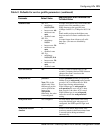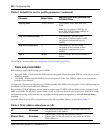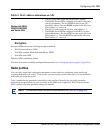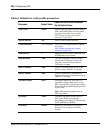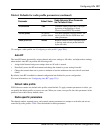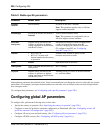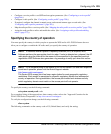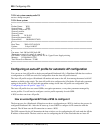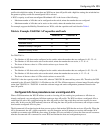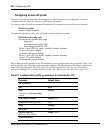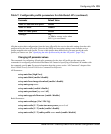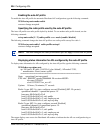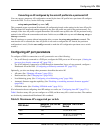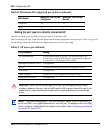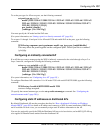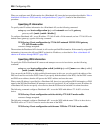
Configuring APs 231
Nortel WLAN—Security Switch 2300 Series Configuration Guide
profile with a high bias setting. If more than one WSS has an Auto-AP profile with a high bias setting, the switch that has
the greatest capacity to add new unconfigured APs is selected.
A WSS’s capacity to add new unconfigured Distributed AP’s is the lesser of the following:
• Maximum number of APs that can be configured on the switch, minus the number that are configured
• Maximum number of APs that can be active on the switch, minus the number that are active
For example, suppose the Mobility Domain has two WSSs, with the capacities and loads listed in Table 6.
For 2360/2361 A:
• The Number of APs that can be configured on the switch, minus the number that are configured, is 30 - 25 = 5.
• The Number of APs that can be active on the switch, minus the number that are active, is 12 - 8 = 4.
• The lesser of the two values is 4. The switch can have up to 4 more APs.
For 2360/2361 B:
• The Number of APs that can be configured on the switch, minus the number that are configured, is 30 - 20 = 10.
• The Number of APs that can be active on the switch, minus the number that are active, is 12 - 12 = 0.
• The lesser of the two values is 0. The switch can have no more APs.
2360/2361 A has the capacity to add 4 more APs, whereas 2360/2361 B cannot add any more APs. Therefore, the WSS
contacted by the AP sends 2360/2361 A’s IP address to the AP. The AP then requests a software image file and configu-
ration from 2360/2361 A. 2360/2361 A sends the software image and sends configuration parameters based on the
Auto-AP profile.
Configured APs have precedence over unconfigured APs
When a WSS determines the WSS IP address to send to a booting AP, the switch gives preference to APs that are
already configured, over unconfigured APs that require an Auto-AP profile. The WSS can direct a configured AP to a
switch that has active APs configured using the Auto-AP profile, even if the switch does not have capacity for more
active APs. In this case, the WSS randomly selects an AP using the Auto-AP profile to disconnect, and accepts a connec-
tion from the configured AP in its place.
The disconnected AP can then begin the boot process again to find another WSS that has an Auto-AP profile. When the
AP is disconnected, the AP’s clients experience a service disruption, and will attempt to associate with another AP if
available to reconnect to the SSID they were using. If another AP is not available to a client, the client can still reconnect
after the disconnected AP is connected to a new WSS and finishes the boot and configuration process.
Table 6: Example 2360/2361 AP capacities and loads
2360/2361 A 2360/2361 B
Maximum Configured 30 30
Maximum Active 12 12
Number Currently Configured 25 20
Number Currently Active 8 12



